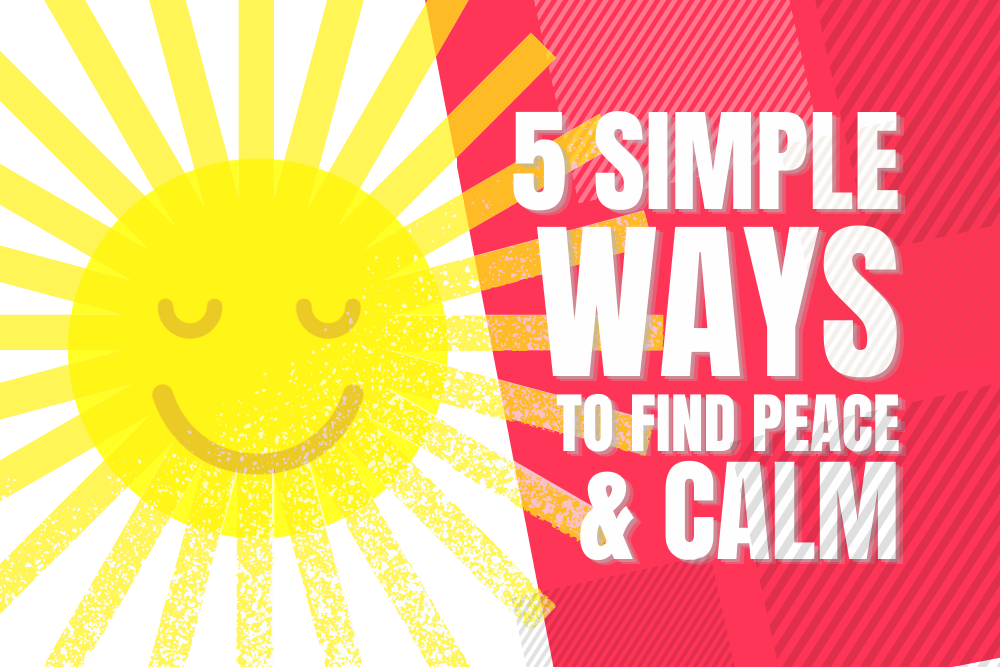5 Simple Ways To Find Peace & Calm
Sometimes as a parent, it can feel like you don’t have a minute to stop and catch your breath! With the return to school and our busy lives, it’s easy to feel stressed and overwhelmed. Finding ways of restoring peace and calm to our day is an important act of self-care. When we find ways to manage our stress, we have more ability to be there for our children, and we also teach them the importance of learning to create calm in their world.
This is of course easier said than done! It can feel like we just don’t have the time to prioritize ourselves in this way. So, here are five simple ways to create a sense of calm and serenity for you to try:
Take a Mindful Walk:
Often as we walk around, our minds are filled with where we’re headed and what we need to do when we get there. Instead, try walking mindfully. Get outside if you can- but you can even do this at home:
As you walk, feel your feet on the ground. Take in the sensation of how this feels. Breathe deeply and slowly. Pay attention to how your body feels as you move through space, walking calmly. How do your muscles feel? Focus on them as you take each step. Take in what is around you. What do your senses reveal? What colors and shapes do you see? What scents can you smell? When distracting thoughts come, bring your focus back to the experience of walking.
Practice Positive Self Talk:
Positive affirmations can have a powerful, calming effect. When stress overwhelms you, give yourself some encouragement. Remind yourself that you are capable, strong and resilient. Pat yourself on the back for all you have and continue to accomplish. Tell yourself how amazing you are. Do this by repeating a calming and affirming phrase over and over such as, “I can handle this situation”, “I am strong”,” I am working towards my goals”,” I can achieve what I want in life”, or whatever makes you feel competent, confident and more at peace.
Visual Imagery:
Sometimes as much as we wish we could be off on a beautiful island somewhere, it just isn’t possible. However, this doesn’t mean we can’t reap some of the benefits of being somewhere calm and beautiful, without actually being there. Find a quiet spot inside or outside. Sit down and close your eyes. Visualize yourself somewhere you’ve been or where you want to go that brings you a sense of serenity. Breath deeply and slowly. Imagine yourself there. Visualize what you would see around you, what sounds you would feel. Allow yourself to feel the sense of calm this place would bring you. Allow yourself to “stay there” for as long as you need.
Get Some Exercise:
Feeling anxious and stressed? Exercise is a natural mood booster. It increases chemicals called endorphins in the brain that help improve our mood. Though any exercise can be beneficial (in fact if you’re feeling down, a ten-minute spurt of exercise can help), it’s important to find something you like. This will motivate you to continue.
If scheduling it is a challenge- be flexible. There is no need for a gym or any equipment; save time by going for a simple walk, or follow a youtube workout video at home. You can also get in 10 or 15 minutes here and there throughout the day- we all can find 10 minutes every few hours to prioritize ourselves.
Guided Meditation:
Meditation has many mental and physical health benefits. Practiced regularly it reduces stress, improves mood, emotion regulation and overall physical health. It can be difficult to know how to get started, so guided meditation is a great tool with free options available to support you as you begin your meditation journey. Guided meditations can include music and/or guided instruction through your meditation experience through such things as creative imagery and mindfulness practices. Meditation can be done easily at home, doesn’t take up much time, and is immediately calming.
These are some simple tools to begin with. Try them and explore your own healthful strategies for calm and self-care. Remember, self-care is never selfish, but necessary for us to be at our best for ourselves and those we love. You can also teach your children to practice these coping skills and help them to learn to value their own self-care and positive ways to find calm.

